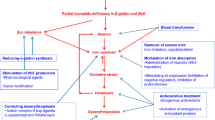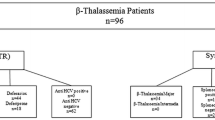Abstract
Hyper-ferrous state is the result of multiple transfusions, whereby the iron excess in such conditions may be toxic to the organism. Patients suffering from thalassemia receive multiple transfusions. In the eastern part of India, both β0-thalassemia and heterozygous Eβ-thalassemia occur. This paper expresses the hyper-ferrous state, leading to iron overload in these two conditions and also reports the increased generation of free radicals, consequent to the iron overload.
Similar content being viewed by others
References
Conrad, M.E. (1998). Introduction: Iron overloading disorder and iron regulation. Seminars in Hematol. 35 (1), 1–4
Halberg, L. (1981). Bioavailability of dietary iron. Ann. Rev. Nutr. 1 (1), 123–125.
McCord, J.M. (1992). Superoxide production and human disease. In Jesaitis, A. and Dratz, E. (eds.): Molecular basis of oxidative damage by leukocytes. Boca Raton. FL. CRC, pp. 225–239.
McCord, J.M. (1974). Free radicais and inflammation: Protection of synovial fluid by superoxide dismutase. Science 185, 159–163.
Halliwell, B. and Gutteridge, J.M.C. (1992). Biologically relevant metal ion-dependent hydroxyl radical generation-An update. FEBS Lett. 307, 108–112.
Gutteridge, J.M.C., Rowley, D.A. and Halliwell, B. (1982). Superoxide dependent formation of hydroxyl radicals and lipid peroxidation in the presence of iron salts. Biochem. J. 206, 605–609.
Biomond, P., Swaak, A.J. Bemdorff, C.M.et al. (1986). Superoxide dependent and independent mechanisms of iron mobilization from ferritin by xanthine oxidase implications for oxygen-free radical-induced tissue destruction during ischaemia and inflammation. Biochem. J. 239, 169–173.
Biemond, P. van Eijk, H.G., Swaak, A.J.G.et al.. (1984). Iron mobilization from ferritin by superoxide derived from stimulated polymorphonuclear leukocytes. Possible mechanism in inflammation diseases. J. Clin. Invest. 73, 1576–1579.
van Assendelft, O.W. and Lewis, S.M. (1991). Recommended method for the determination of the haemoglobin concentration of blood. WHO Docum. Lab. 8 fold Rev. 1.
Drabkin, D.L. and Austin, J.H. (1932). Spectrophotometric studies: Spectrophotometric constant for common hemoglobin derivatives in human, dog and rabbit blood. J. Biol. Chem. 98, 719–733.
Ohkwa, M., Ohighi, N. and Yagi, K. (1979). Assay for lipid peroxides in animal tissues by thiobarbituric acid reaction. Analyt. Biochem. 95, 357–358.
Chatterjee, C.C. (1983). Human Physiology. Volume II. Medical Allied Agency, India pp. 10–11.
Author information
Authors and Affiliations
Corresponding author
Rights and permissions
About this article
Cite this article
Goswami, K., Ghosh, S., Bandyopadhyay, M. et al. Iron store and free radicals in thalassemia. Indian J Clin Biochem 20, 192–194 (2005). https://doi.org/10.1007/BF02867427
Issue Date:
DOI: https://doi.org/10.1007/BF02867427




